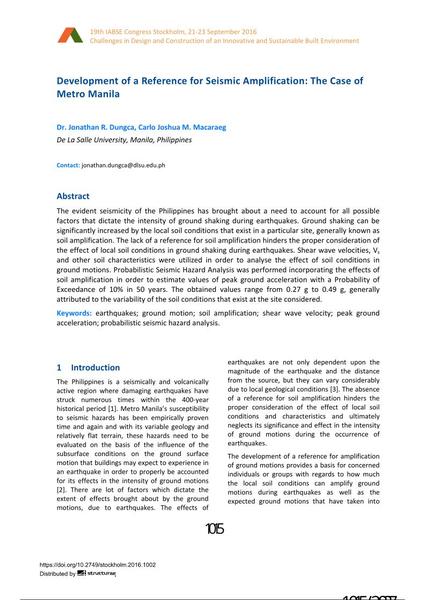Development of a Reference for Seismic Amplification: The Case of Metro Manila

|
|
|||||||||||
Détails bibliographiques
| Auteur(s): |
Carlo Joshua Mendoza Macaraeg
(De La Salle University, Manila, Philippines)
Jonathan R. Dungca (De La Salle University, Manila, Philippines) |
||||
|---|---|---|---|---|---|
| Médium: | papier de conférence | ||||
| Langue(s): | anglais | ||||
| Conférence: | IABSE Congress: Challenges in Design and Construction of an Innovative and Sustainable Built Environment, Stockholm, Sweden, 21-23 September 2016 | ||||
| Publié dans: | IABSE Congress Stockholm, 2016 | ||||
|
|||||
| Page(s): | 1015-1022 | ||||
| Nombre total de pages (du PDF): | 8 | ||||
| Année: | 2016 | ||||
| DOI: | 10.2749/stockholm.2016.1002 | ||||
| Abstrait: |
The evident seismicity of the Philippines has brought about a need to account for all possible factors that dictate the intensity of ground shaking during earthquakes. Ground shaking can be significantly increased by the local soil conditions that exist in a particular site, generally known as soil amplification. The lack of a reference for soil amplification hinders the proper consideration of the effect of local soil conditions in ground shaking during earthquakes. Shear wave velocities, Vs and other soil characteristics were utilized in order to analyse the effect of soil conditions in ground motions. Probabilistic Seismic Hazard Analysis was performed incorporating the effects of soil amplification in order to estimate values of peak ground acceleration with a Probability of Exceedance of 10% in 50 years. The obtained values range from 0.27 g to 0.49 g, generally attributed to the variability of the soil conditions that exist at the site considered. |
||||
| Mots-clé: |
tremblements de terre
|
||||
